Blogs
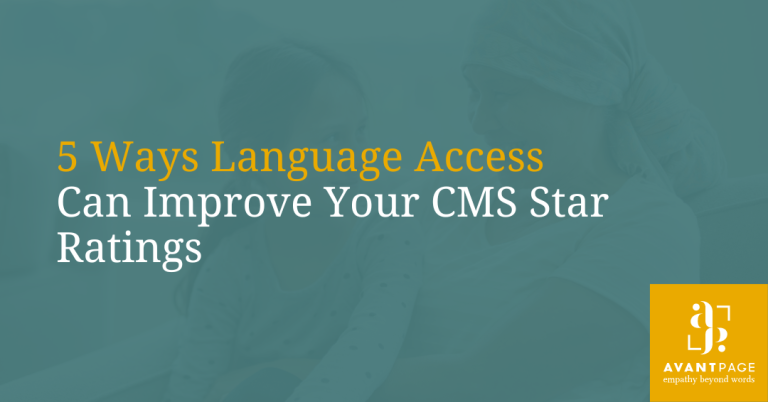
5 Ways Language Access Can Improve Your CMS Star Ratings
Every year, the Centers for Medicare & Medicaid Services (CMS) release a series of star ratings that patients can use to evaluate the quality of the services that a Medicare Advantage health plan offers. As a health insurance provider, it’s important to make sure your CMS star rating is in tip top condition. CMS star ratings help patients identify high-quality Medicare health plans, with a five-star rating indicating excellence. If your rating falls below this threshold, not only will patients be less likely to select your plans, but you could face penalties and fines from the CMS. The CMS calculates its star ratings on a scale of 1 to 5 based on the following factors: If your CMS star ratings slip or you’re simply looking for new ways to improve your services, it might be a good idea to look into improving your language access plan. Patients with limited English proficiency (LEP) make up a significant proportion of Medicare recipients, and as such, it’s important to make sure you’re serving them effectively if you want to boost your star rating. By offering a diverse range of language access services for LEP patients, you can improve their overall experience with your organization, thereby increasing your CMS star ratings. Although language access is not factored directly into your CMS star rankings, improving language access can help you perform better on the other measures that the CMS uses to calculate your star rankings. In this blog post, we’ll take a look at how your agency can improve its language access services and, in turn, boost your CMS star rating. Nearly 10% of the United States’ population has LEP, meaning that they are unable to effectively understand or communicate in English. Research suggests that immigrants — particularly those with LEP — are more likely than their U.S.-born counterparts to be enrolled in Medicare services. And given that the number of older individuals with LEP is projected to grow significantly over the course of the next 40 years (by 2060, experts predict the number of older LEP immigrants will grow to 22 million, up by 15 million from 2018), it’s important to make sure that you’re able to serve this population just as well as you’re able to serve English speakers. Patients — regardless of the language that they speak — need to be able to understand their health status and communicate effectively with their healthcare providers and insurance agencies. By offering language access services that improve your organization’s transparency, outreach, and communication with consumers, you can contribute to improved health outcomes for the country’s growing population of individuals with LEP. Effective CMS Marketing for Multilingual Healthcare Materials A Guide to Finding a Medicare Translation Agency Fast Print & Mail Translations for Health Plans While the CMS won’t take your language access measures into account when developing star ratings, high-quality language access is likely to improve your performance on the measures that they do factor into their star ratings. In recent years, CMS star ratings have been on a downward trend — more and more providers are performing worse than they have in past years. And that could be because many of them aren’t well-prepared to meet the needs of their patients with LEP. Let’s take a look at the different factors that go into your CMS star ratings, and how improving language access can help you improve your score on each. The CMS looks at the mortality rates of patients enrolled in a specific plan when determining their star rankings — the lower your mortality rate, the higher your star rating will be. LEP appears to be a factor that can increase mortality rates — according to a report published in 2016, LEP “was associated with a 31% increased odds of mortality” among patients with sepsis, even after accounting for illness severity, comorbidities and other factors. While it depends on the type of healthcare issue patients face, making sure they are well-informed about their plan and comfortable seeking out the treatment they need, you can lower the overall mortality rate of your plan. In the case of LEP patients, translating important medical information and offering interpretation services as needed will empower patients to make informed choices about their healthcare. This measure looks at the rate of serious complications patients can potentially face when seeking treatment, such as surgery site infections or catheter-induced urinary tract infections. Language access may not directly impact this measure, but you should be able to effectively communicate the level of risk patients might face. Additionally, making sure interpreters are available and present either in person or remotely can ensure patients are knowledgeable about the health procedures they’re undergoing, allowing them to make decisions accordingly. If patients frequently have to return to the hospital after surgeries or health emergencies like heart attacks and stroke, your CMS star rating will go down. Patients with LEP have been shown to have particularly high readmission rates when compared to patients who speak English. If you’re looking to reduce readmission rates, it’s a good idea to look into whether or not your readmission rates are higher for your LEP patients. If it is, working with a language service provider to improve your language access could be a good first step to improving this measure. In 2017, researchers found that access to interpreters had a significant impact on lowering the readmission rates for patients with LEP, from 17.8% to 13.4%. CMS star ratings also take the patient reviews into account — if patients aren’t satisfied with the care they’re receiving, it could take your rating down a notch. While it’s true that language access can be a matter of life or death in certain situations, it’s also an important way to make patients feel more comfortable, regardless of the severity of their health situation. LEP patients who have access to high-quality language access services may be more likely to report a positive patient experience, which could give your rating a well-needed boost on this measure. The longer it takes to give patients effective care, the lower your star rating is likely to be here. And wait times tend to be much longer for patients with LEP than for English-speaking patients: A 2022 study found that folks with LEP spend an average of 31.9 minutes in the waiting room, while English speakers wait just 21.8. On this measure, interpreters can play a particularly important role — if patients with LEP regularly have to wait for a long time to receive interpreting services, it could delay their access to effective care, ultimately hurting your star rating. Work with a language service provider to make sure interpreting services are available on standby so that you can get them access to an interpreter as soon as possible. Your CMS star ratings are an important way for patients to understand the quality of care they’re receiving. In order to avoid penalties and fines, it’s important to aim for a five-star rating; considering the unique needs of LEP patients, language access is likely to play an important role in reaching that perfect score. If you’re looking to improve your language access services and boost your CMS star ratings, Avantpage is here to help. We know how important language access is for LEP patients and are proud to provide specialized translation, interpreting, and localization services for healthcare providers. Contact us today at [email protected] or (530) 750-2040.
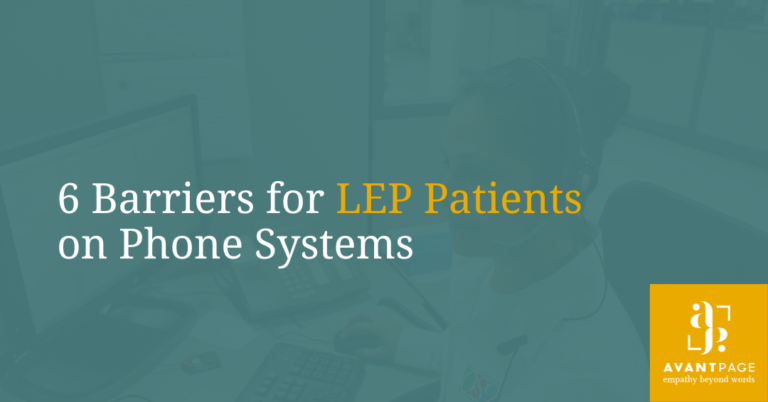
6 Barriers for LEP Patients on Phone Systems
Whether you’re calling customer service to help you set up your new computer or simply want to get in touch with a local government agency, phone systems and call centers can be tricky enough even for native English speakers to navigate. Faulty voice recognition software and confusing instructions cause frustration for many of us, but they’re even more likely to cause problems for callers with limited English proficiency (LEP). For individuals with LEP, making a simple phone call to a government agency, medical institution, or any other organization can become a daunting task if the phone system isn’t set up with their needs in mind. Many organizations provide over-the-phone interpreting services — as they should — but inadvertently set up their phone systems with critical breakdown points for LEP users. When it comes to language access over the phone, interpreting isn’t enough: Your phone system also has to be as user-friendly as possible. With open enrollment season upon us healthcare organizations and insurance agencies are bound to receive heightened demand on their phone systems and call centers. That means it’s crucial to reflect upon ways they can improve the experience they provide for callers with LEP. Here, we’ll explore some especially common barriers that LEP patients encounter when contacting call centers for various organizations.
Your phone system can make or break an individual’s experience seeking out help from your agency. Here are some common troubles that people with LEP encounter when trying to contact healthcare providers and insurance agencies over the phone — and ways that you can help improve their experience and provide them the service they expect. Complex phone trees can be a major obstacle for anyone — and particularly so for patients with LEP. While simplifying your phone tree is ideal, it’s not always feasible for every organization. Still, there are ways to reduce breakdowns even if you can’t create a simpler phone tree. If callers have to listen to and select from several menu items, it’s a good idea to have separate phone numbers for different languages, making it more efficient for individuals to reach the right department without frustration. It’s critical for organizations to have clear methods for identifying the patient’s preferred language before calling an interpreter. After all, you certainly don’t want to misidentify a caller’s language and wind up with an interpreter that doesn’t speak their language. Self-identification is one common method that phone systems utilize — i.e., have menu items that read “For English, press one” and “Para español, marque dos,” et cetera., that connect speakers to employees or interpreters who will help them out in their preferred language. Additionally, artificial intelligence tools that can automatically recognize a speaker’s language using voice recognition are slowly but surely growing to be more competent, and could one day be useful to implement in your phone systems. If a caller does get connected to somebody that doesn’t speak their language, employees should be prepared to contact an interpreter and inform them that an interpreter will be on the line shortly. This information must be conveyed clearly and quickly — individuals with LEP may not stay on the line for long if they cannot effectively communicate with the other person on the line, so letting them know that help is on the way is key. A pre-recorded message saying “Please hold for an interpreter” in the caller’s primary language should be an effective way to keep the caller on the line while you wait for an interpreter to come on the line. Additionally, some agencies opt to create phonetic guides that employees can use to read the message to callers in a handful of different languages; this way, employees can convey the message on their own, without having to actually speak the language in question. One of the most common barriers for LEP patients is the lack of proper employee training — if employees are not properly trained, communication may be inefficient and callers will quickly grow frustrated or confused and hang up. Make sure to offer comprehensive training to your employees during the onboarding process, covering topics such as how to call interpreters and how to use your organization’s phone system to connect with them effectively. It’s important to keep the caller on the line at all times. Some set-ups require an employee to disconnect the call and then call the patient back — this is far from ideal, as it can confuse the caller and, depending on how long it takes to call them back, they may not pick up the second call. Additionally, LEP patients may not even be able to give your employees their phone number, considering the language barrier that required an interpreter in the first place. Make sure that your employees can seamlessly connect with the interpreter without hanging up and calling them again — this may simply be a matter of re-training your employees or implementing a more advanced phone system. If your organization uses bilingual messaging in voicemails, it’s important to include a notice in the target language at the beginning of the message. All too often, LEP patients have to listen to a long, drawn-out message in English — unsure of whether or not it will be followed by a translation in their language — before hearing the message in their language. While bilingual messaging is certainly important, be sure to present it in a logical manner. Before starting your English message, consider including a simple opening line in the target language that reads along the lines of “This is a bilingual message,” so callers know to expect a translation following the English message. This step eliminates confusion and ensures that the LEP patient knows to listen to the entire message before hanging up or leaving a message. This open enrollment season, take some time to consider ways in which your phone system and call center processes can be improved to create a smoother experience for callers with LEP. Here are some ways to eliminate common barriers LEP callers may face: At Avantpage, we’re proud to provide over-the-phone interpreting services to help your organization connect with clients who have LEP. Contact us today at [email protected] or (530) 750-2040 for more information.
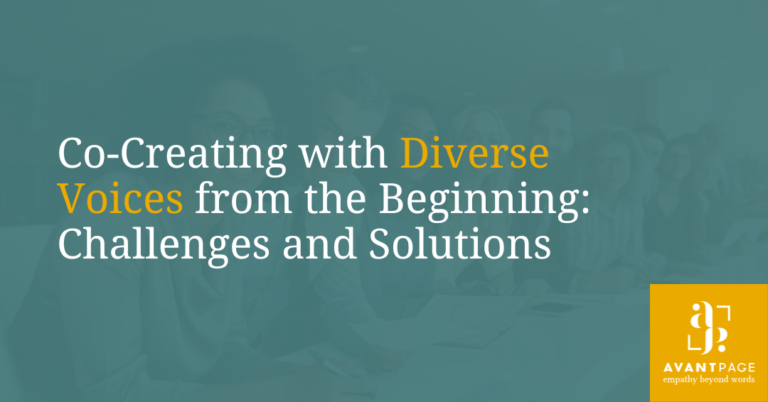
Co-Creating with Diverse Voices from the Beginning: Challenges and Solutions
Earlier this year, Avantpage teamed up with the Athena Group, a women- and minority-owned consulting firm focused on diversity, equity, and inclusion (DEI), to host a virtual event on how to forge connections and build resilient, inclusive communities. This event brought together government stakeholders seeking to enhance their approach to language access and equity within their organizations. Attendees were eager to explore successful strategies and identify common challenges, and one overarching theme emerged: the challenge of creating programs and services that center the voices of diverse communities with limited English proficiency (LEP) from the very beginning of a project. If you missed our session with the Athena Group, fear not — in this blog post, we’ll dive into some of the key topics discussed at the event, namely common challenges and solutions to engaging diverse communities from the very get-go.
If your organization is looking for ways to better serve people with limited English proficiency, it’s important to seek input from individuals who actually have LEP. Asking for and actually incorporating feedback from diverse communities into your programs and services is critical to making sure that your organization can effectively serve these people. However, that can be a lot easier said than done. Here are some of the main challenges organizations face when it comes to trying to engage diverse communities, particularly those with LEP — and more importantly, solutions that you and your team can implement to get around those challenges. Rural communities often face barriers that communities in big cities and even the suburbs do not — research shows that people living in rural areas typically face a lack of important resources compared to their urban counterparts. And as the population of folks with LEP in rural areas grows, organizations need to be able to address the unique needs of people from diverse linguistic backgrounds living in rural areas. Building relationships with local organizations is key, as this helps bridge the gap between your organization and the community you’re targeting. By forming partnerships with local organizations that are knowledgeable about a given community in a rural area, your team can be more considerate of the needs of the rural communities that you serve. Community members with LEP are fairly unlikely to participate in — or even show up to — public meetings conducted entirely in English. After all, would you feel comfortable attending a town hall in a language you can’t understand without any accommodations made to help you do so? Make sure to offer language services like interpreting and translation at public gatherings with local communities, so individuals with LEP feel welcome and like their voice will be heard. Leading up to the event, make sure to clearly communicate what language access services will be available, so that prospective participants know what to expect. And beyond language services, it’s also important to make sure that the timing and location of your meeting are accessible as well, so that you’re able to reach as many community members as possible. Offering incentives for participation is also a good idea — by compensating participants for time otherwise spent, you lessen the burden of attending a meeting. Engaging with frontline communities can be challenging. Leveraging existing relationships with trusted community groups like nonprofits and community-based organizations (CBO) is a good strategy to invite under-connected populations such as communities of color, low-income individuals, youth, elderly communities, immigrant communities, those with disabilities, and young families. And if you don’t already have existing relationships with local CBOs, read our guide on partnering with CBOs and how they can be an especially helpful resource in your efforts to engage local communities. One reason people — particularly people with LEP — often feel disengaged or uninterested in an organization’s services is simply because they are presented using language that is challenging to understand. Oftentimes, organizations use complicated jargon that might make sense internally, but confuses their audience. Working with a skilled copywriter and a language service provider is crucial to ensuring that the language you use doesn’t overwhelm and alienate your audience. It may also be helpful to brainstorm different ways to present the information as well — infographics can be a really helpful way of simplifying and visualizing concepts without writing too much copy. Plus, they may also be easier and quicker to translate for audiences from different linguistic backgrounds, as they tend to be lighter on copy than, say, a blog post or a dense informational pamphlet. Low participation and attrition rates can also hinder your organization’s progress. To address this, you may want to consider providing hourly stipends for targeted engagement as a way to alleviate the costs of participation, which might include taking time off work, arranging childcare, and transportation. Alternatively, you could also consider providing meals or other items that could encourage people to show up. Additionally, try to be mindful of the information that you collect during registration, especially when working with immigrant communities. And as we’ve mentioned before, be sure to inform attendees about the availability of free-of-cost language services and accessibility — while it’s great to offer language access services, they won’t be very helpful in attracting participants if prospective participants are unaware of their offering. Acknowledging that past actions may have caused harm to the marginalized communities that you’re looking to serve is a crucial step in co-creation, as it allows community members to develop a sense of trust in your organization. Start with internal work, such as implicit/explicit bias training, assessing the team’s intercultural competence, and developing a community charter to begin paving the way for more respectful and equitable collaboration.
It can be hard to engage diverse communities and incorporate their perspectives into your work — but it’s absolutely critical for any organization to do so. Here are some recommendations for mitigating some of the challenges your organization might encounter when attempting to co-create with diverse communities like immigrants or people with LEP:
At Avantpage, we’re proud to work with organizations looking to better engage communities with LEP. We provide translation, interpreting, and localization services to help you connect with people from all linguistic backgrounds — contact us today at [email protected] or (530) 750-2040 to learn more.
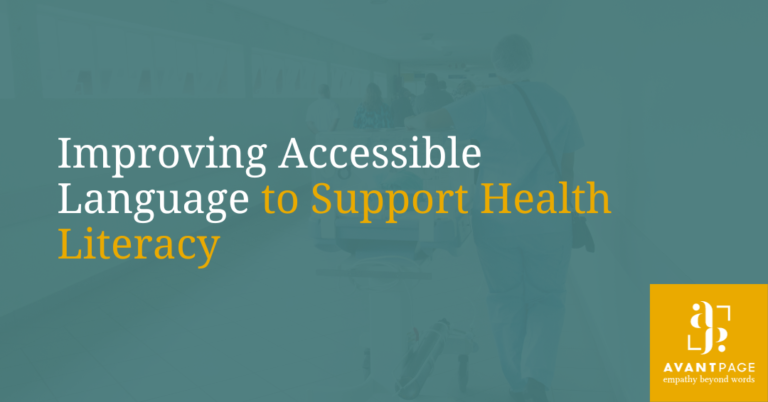
Improving Accessible Language to Support Health Literacy
It should come as no surprise that strong health literacy is associated with more positive health outcomes. Health literacy — that is, an individual’s ability to understand and utilize information on health and medical care — is an important part of being able to advocate for yourself in a healthcare setting, whether that’s at the emergency room or a routine check-up. In one 2022 study, researchers found that hospital patients with poor health literacy were more likely to revisit the hospital 90 days after discharge than patients with adequate health literacy. But developing a strong sense of health literacy can be difficult — especially since a good deal of medical literature and information is presented in complex, inaccessible language. Even more challenging is developing a strong sense of health literacy when you have visual impairments that make it difficult to read this information in the first place. On its own, then, accessible language isn’t enough — healthcare providers also need to ensure blind and low-vision patients have access to health information in alternative formats like braille, audio recordings, and large print. In providing a breadth of information in various accessible formats, healthcare providers can promote improved health outcomes for all of their patients. The beginning of October marks National Disability Employment Awareness Month, a time to highlight the importance of making healthcare information and services accessible to all individuals, regardless of their abilities. In this blog post, we’ll explore the crucial role of health literacy in achieving positive health outcomes and explore ways to improve health literacy using accessible language and alternative formats. The vast majority of people in the US have limited health literacy — according to Pfizer, just 12% of people in the nation are proficient when it comes to their health literacy. Health literacy isn’t necessarily about being able to understand medical jargon or decipher dense medical texts — after all, regular patients can’t be expected to understand health and medicine at the same level as trained doctors, nurses, or pharmacists. Health literacy, then, is more about being able to parse through the information a doctor or healthcare provider gives you in a way that allows you to make informed decisions about your well-being. Individuals who are health literate are better prepared to navigate the healthcare system and can play a more active role in their medical care. People with limited health literacy often struggle to fully understand their health conditions. They may also struggle with figuring out how to properly apply their medications and maintain good health overall. Consequently, they may experience poorer overall health, higher healthcare costs, and an increased likelihood of rehospitalization and mortality. On the other hand, individuals with better health literacy are more likely to experience improved health outcomes. They can better comprehend basic health information, communicate effectively with healthcare providers, and make informed decisions about their care. As such, it’s in everyone’s best interest to close the gaps in health literacy. With a more health literate population, hospitals can reduce readmission rates, in turn lowering the amount of stress placed on our healthcare system and improving health outcomes for society as a whole. One of the first steps to closing gaps in health literacy is to ensure that patient-facing documents and other materials are provided in accessible language. That means language that’s welcoming and easy to understand. While there’s a time and place for medical jargon, it’s important that complex topics are presented in a way that’s actually meaningful to the patient. If you’re looking to provide patients with information that can boost their health literacy, you may want to look at some of your pre-existing materials — flyers, brochures, webpages, etc. may benefit from a complete rehaul to clean things up. It’s important for every step of the patient journey to be as accessible and understandable as possible — from scheduling appointments online to informational pamphlets about a specific health condition. Read our guide on plain language to learn more about how you can present information to patients in an easily understandable fashion that sheds light on their health condition. Here are just a few of the benefits of using accessible language with your patients: However, we shouldn’t stop at accessible language. Some groups face unique barriers when it comes to health literacy. For example, researchers at the University of Illinois at Urbana-Champaign have noted that individuals with visual impairments may struggle more in honing their health literacy skills due to the fact that they’re less able to access certain visual cues that can aid them in deciphering relevant medical texts. As such, it’s important to refine this approach by making sure that relevant materials are accessible in alternative formats for people with visual impairments. Here are a few examples of alternative formats that can be used to ensure that people of diverse abilities are able to access your content: Once you’ve written your materials in accessible language, it’s time to work with an alternative format service provider to make sure that your content is accessible for every patient. By providing patients with accessible information in various alternative formats, you can help elevate your patients’ health literacy and improve outcomes for all. As we recognize National Disability Employment Awareness Month this year, we encourage healthcare providers to take the following steps to promote health literacy: At Avantpage, we’re committed to supporting healthcare organizations in their journey toward improved accessibility. We offer a comprehensive range of alternative format services, including audio, braille, and large print, to ensure that healthcare information is accessible to all — if you’re looking to boost health literacy among your patients, contact us today at [email protected] or (530) 750-2040.
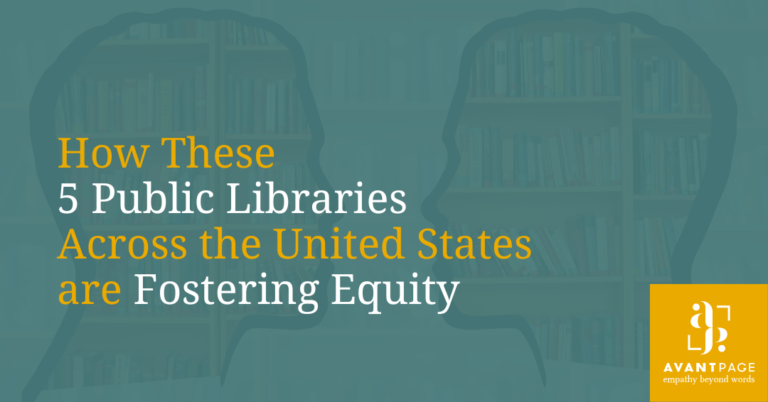
How These 5 Public Libraries Across the United States are Fostering Equity
Public libraries are a lot more than just book repositories. Historically, public libraries in the United States have served as safe havens for community members from all walks of life. Beyond providing us with a wealth of free literature and knowledge, they also host programming, events, and resources that aim to promote a sense of equity within the community. Typically offered at little or no cost, these unique library programs serve to democratize human knowledge and make it more accessible than ever. Libraries play a particularly crucial role in fostering linguistic diversity and equity within their community by addressing the unique needs of minority populations. Libraries across the country may offer unique library programming like English as a second language (ESL) instruction for members of the community looking to sharpen their English skills, as well as programming and events hosted in different languages spoken prominently throughout their locale. And that’s not to mention that libraries also offer a huge collection of books, talking books, movies, and other media in several different languages spoken throughout their local community. In this blog post, we’ll examine the work that five public library systems are doing to promote a sense of equity in their local communities, taking a particularly close look at their work for community members with limited English proficiency (LEP).
In an effort to meet the needs of Santa Barbara’s growing population of Spanish speakers, the Santa Barbara Public Library formed its Spanish Outreach Team back in January 2022. Prior to the launch of the Spanish Outreach Team, the library’s employees had noticed a higher demand for Spanish-language services, and made a concerted effort to hire more Spanish-speaking staff. But to make sure that Spanish speakers in the community were aware of the diverse range of services the library system offered, they decided it wasn’t enough to hire Spanish-speaking staff — they also needed to target the Spanish-speaking community in their outreach efforts. By doing so, the staff say they’ve made Spanish-language titles more accessible to Santa Barbarans with LEP, while also allowing them to tap into just as much knowledge as their English-speaking counterparts.
New York City is widely cited as the most linguistically diverse place in the world, with more than 800 different languages represented among the city’s residents. So it shouldn’t come as a surprise that the city’s public library system is embracing the city’s linguistic diversity and promoting equity through multilingual services. New York residents with LEP can enroll in free English courses at the library, while learners of other languages can also take classes and participate in conversation groups as well. Members of the library also have free access to Mango Languages, allowing them to sharpen up their language skills from their own homes. Meanwhile, the library system also has a comprehensive outreach strategy that involves translating marketing materials and information on the library’s services into several languages spoken throughout the community. The library also has a huge slate of events planned for Hispanic and Latinx Heritage Month this month, including bilingual storytimes for Spanish-speaking children. And every April, the library system hosts an annual World Literatures Festival, celebrating books and authors from all across the world.
The Russian invasion of Ukraine in 2022 led to one of the largest refugee crises in Europe’s history. While most resettled in various locales throughout Europe, more than a quarter million found themselves displaced in the United States. To promote cultural awareness among residents of their local community, Kansas University and the nearby Lawrence Public Library partnered up earlier this year to host a series of panels and events on Ukrainian culture, history, and the ongoing war in the country. And this past spring, the library also offered Ukrainian courses for members of the community interested in familiarizing themselves with the national language of Ukraine.
Much like the city of Santa Barbara, Washoe County, Nevada has also seen a pretty big surge in the local Hispanic and Latino population over the last few years. With that rising population, the local library system has seen demand for Spanish-language services increase significantly. So, the Washoe County Library began hosting bilingual story time events, in which a reader shares a story to children in both English and Spanish. The team behind this effort believes that reading to children in both Spanish and English allows Spanish-speaking children to hear the language outside the home and “normalize” using it outside of their household. Over time, the library system has begun offering a wide range of programming and resources for Spanish speakers and folks from other linguistic backgrounds, including ESL courses and a Spanish-language research database.
As we’ve discussed above, bilingual story time events are a good opportunity for children from diverse linguistic backgrounds to practice their native language with people outside of their household. That’s why the Sno-Isle Library system in the state of Washington is planning on expanding its story time program to offer these events in Spanish, Russian, and Korean, among a handful of others. The library system recently received a $100,000 grant from the Gates Foundation, which it’s partly using to improve its outreach strategy. By working with speakers of different languages, the library system is hoping to make its resources and services more accessible to populations with LEP, allowing them to tap into the wealth of knowledge available through the library system.
Libraries hold great potential for promoting linguistic diversity and equity — from language courses, to multilingual story hours, to collecting multimedia in several different languages, libraries have the ability to empower individuals from all sorts of linguistic backgrounds. If you work for a library and would like to improve your multilingual programming, resources, and outreach to LEP communities, Avantpage is happy to help. We offer translation, localization, and interpreting services that can boost your multilingual, multicultural outreach efforts. Contact us today at [email protected] or (530) 750-2040 for more information.

5 Key Insights from an Account Manager on Leveraging Language Data
At Avantpage, we pride ourselves on being a highly data-driven company. And we understand that our clients want to be able to access the same technology and insights into language data that we use internally — that’s why we developed our signature customer portal, AvantPortal. AvantPortal is a comprehensive platform that offers a wide range of features tailored specifically to our customers’ needs. From seamless service requests to streamlined invoice management, file organization, and communication between the client and Avantpage, the portal’s multifaceted capabilities empower clients to navigate translation projects with finesse. We’ve designed and developed our customer portal with your priorities in mind, ensuring that clients are able to tap into a wealth of insightful language data and more. This data can help you work smarter and faster, allowing you to reduce costs and get even more value out of our language services. In AvantPortal, you have access to a customized dashboard that includes all sorts of useful information at a glance, including translation criteria, current and past projects, quotes, contact information — just to name a few. If you want to really get into the weeds, you can monitor the status of your entire project workflow to know exactly where you are on project delivery status, KPIs like project frequency, number of requests, timeliness, and more. We worked with our account manager Eduardo Diaz to help you come up with ways to leverage language data and make the most out of your experience with AvantPortal. In this blog post, we’ll shed some light on how clients like you can harness this resource to enhance your operational efficiency and strategic decision-making. So without further ado, here are five key things that Eduardo says clients should know about AvantPortal and how to make the most out of the platform to leverage your language data. AvantPortal is a powerful tool for clients, providing you with key data on translation projects and an easy way to contact key folks in our organization. Here are some tips to get the most out of AvantPortal. AvantPortal provides you with all sorts of spending data that you can use to your advantage when working on future projects with us. By evaluating year-to-date expenditures, clients can assess whether they align with projections or if you’re over-/ under-spending. You can also break down that spending data by language, team, and service to see where things are running most efficiently and where things can be improved. We encourage you to work closely with your account manager to find ways to decrease spending or delegate funding to other kinds of projects. And of course, the portal also allows you to swiftly check payment status and identify any outstanding invoices. Rush translations can run up your bill quite a bit, as they’re typically more costly than translation projects with a longer deadline. Thanks to AvantPortal, you can see which teams and individuals are requesting rush translations frequently so that you can educate them on the importance of preparing ahead of time. Data on rush translations — from who’s requesting them to when they’re being requested most frequently — plays a significant role in refining your operational efficacy (and ours!). In addition to using this data as an educational tool, we can also look at peaks and dips in rush translation demand throughout the year to streamline workflows and anticipate workload fluctuations. Data on translation memory (TM) usage is a goldmine for cost optimization. AvantPortal succinctly reveals the distribution of brand-new terms, fuzzy matches, and 100% matches. These insights can provide you with tangible evidence of savings derived from TM usage. And much like with spending data and rush translation data, you can also use AvantPortal to break down TM usage by language and identify areas for improvement. This in turn will improve your cost efficiency and optimize your savings. Understanding historical trends in service requests is an important part of efficient project management. We urge clients to delve into the peaks and troughs of project volume across months and quarters. This analysis will help you identify patterns of increased demand so you can prepare accordingly. Segmentation by departments, project types, and service categories enhances the precision of this analysis, facilitating more targeted decisions. Your account manager is here to help — AvantPortal makes it easy to get connected with them and take advantage of their wealth of knowledge. The account manager-client partnership thrives when clients provide feedback on how they want to visualize data, driving customized solutions that align with the organization’s unique needs. Our seasoned team of account managers possesses insider insights into industry trends and best practices that can guide you in finding the language data you’re looking for. But they won’t just help you find it — they’ll also help you figure out the best way to actually use it. At Avantpage, we’re proud to have an in-house tool as powerful as AvantPortal. This platform proves to be indispensable for data-driven clients who need insights into the translation project management process.To recap, here are five ways you can use AvantPortal to take your projects to the next level: From cost reduction through spendings analysis to process refinement via rush translation and Translation Memory data, AvantPortal equips clients with the tools they need to make informed decisions. Want to learn more about how you can use AvantPortal to leverage language data? Contact us today at [email protected] or (530) 750-2040.
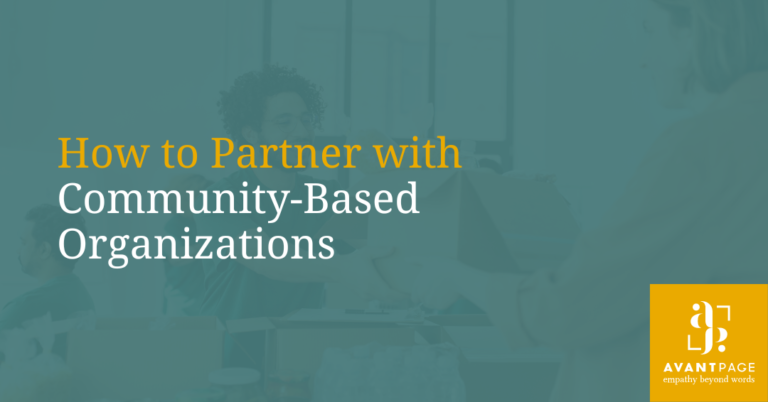
How to Partner with Community Based Organizations
If you’re trying to improve your company or agency’s relationship with local limited English proficient (LEP) populations, you may have been advised to partner up with a community-based organization — but what does that actually mean? Allow us to explain. As defined by the folks at Carleton University’s Community First initiative, community-based organizations, also referred to as CBOs, are “non-profit, non-governmental, or charitable organizations that represent community needs and work to help them. CBOs may be associated with a particular area of concern or segment of the community.” CBOs — examples include mutual aid groups, local LGBTQ centers, and legal funds, just to name a few — play a key role in addressing the unique needs of local communities. These organizations are usually staffed by members of the community or people who are intimately familiar with it, making them essential to creating sustainable change that centers the needs of the local community. If you’re looking to expand your outreach and build trust with local immigrant populations or people with limited English proficiency (LEP), partnering with CBOs is a good first step. Historically, immigrant communities and people with LEP may have developed low trust toward certain groups — for example, government agencies or healthcare providers — due to marginalization or mistreatment. Partnering with CBOs that advocate for the needs of immigrants can help your organization gain the trust of the populations you serve. By partnering with CBOs, you can learn more about the immigrant communities that your organization serves and get a better sense of how to best meet their needs. Building trust might not be easy at first, but over time, CBOs can help you develop a fruitful relationship with historically underserved communities. In this blog post, we’ll go over the how and why of partnering with CBOs, placing particular emphasis on their role in serving immigrant communities and people with LEP.
CBOs can be an extremely helpful resource when you need to gain a better understanding of your local community’s needs. If your organization works closely with immigrants and folks with LEP, partnering with a CBO can be the first step toward providing adequate, accessible services to the community. While working closely with a language service provider (LSP) is a good step toward providing language access, CBOs can better help you determine the unique needs of your locale. CBOs can help you with the things an LSP might not be able to — for example, finding and connecting with local communities, building trust and engaging with them, identifying micro-communities with unique needs, and more. LSPs, on the other hand, can help with language capabilities and processes, follow your unique privacy requirements, leverage data and technology tools to ensure high quality, accuracy, and speed of language service delivery. While LSPs are fairly approachable, many agencies and organizations are a bit unsure of how to go about partnering with CBOs to enhance their language access practices. Here, we’ve identified four key steps to developing a meaningful and mutually beneficial partnership with CBOs:
Partnering with community-based organizations is not just a transactional arrangement; it’s about building genuine relationships and co-creating solutions to address the specific needs of communities. By working together with CBOs, you can foster a sense of trust, inclusion, and belonging that leads to long-lasting, positive change for all parties involved. If you’re looking to learn more about how to combine the strengths of CBOs and translation services, Avantpage is happy to help — contact us today at [email protected] or (530) 750-2040 to speak with one of our experts.
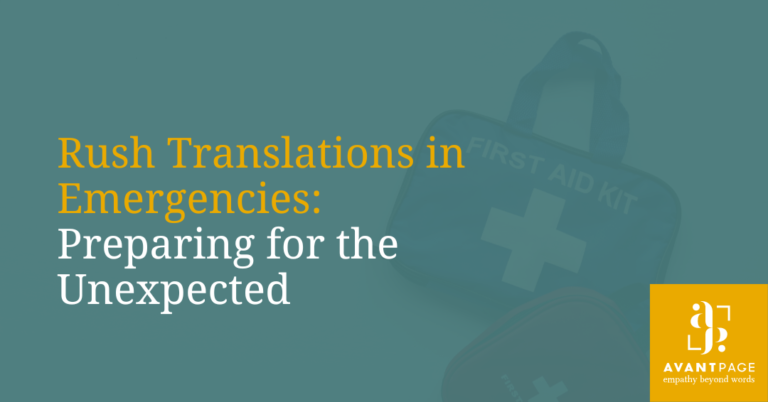
Rush Translations for Emergencies: Preparing for the Unexpected
In times of emergency, effective communication becomes paramount. Being able to understand and be understood can be a matter of life or death in emergencies. Rush translations — i.e., translations that are produced within a tight deadline, usually within 24 hours of the original request and some regulations requiring translation turnaround in as low as 4 hours — play a critical role in breaking language barriers when communication is especially urgent. These services can ensure that vital information reaches those who need it most. It’s especially common for public health organizations, emergency departments, and public information offices to request rush translations to facilitate urgent communication. For example, local health departments might request rush translations of a document warning members of the community about a disease outbreak, while a hospital emergency room might need to rush translate a patient’s old medical documents from a foreign language to give them adequate care. The urgency of rush translations means that there’s even less room for error when it comes to their production. While some agencies might be tempted to use quick and widely accessible tools like Google Translate to prepare an emergency translation, this is not a responsible approach, as it can create an unreliable translation. Instead, it’s important for agencies involved in providing emergency services to work closely with a trusted language service provider (LSP) that’s able to provide quick translation services on the fly. Emergency organizations can form partnerships with LSPs to contract rush translation services before an emergency strikes, allowing for the delivery of quick translations when they’re needed. In this blog post, we’ll explain why rush translations play such an important role in providing adequate emergency services. Read on to learn about the ins and outs of translation services for emergencies — or jump down to the Summary section for a quick recap.
It can be challenging enough to create and distribute effective communications in one language when you’re handling an emergency. But it’s vital to emergency management that agencies provide equally accessible communications materials to individuals with limited English proficiency (LEP). LSPs can help you tremendously with this, but there are also things that you can do on your end to streamline the process and ensure that your organization’s most urgent and time-sensitive communications are translated effectively. Here are four important factors to consider when preparing multilingual communications in response to an emergency: One common challenge associated with rush translations is the potential risk of reduced quality due to the need for speedy delivery. Emergency communications have to occur rapidly, as they typically deal with time-sensitive content. But just because rush translations are produced according to a faster timeline than your usual translation, doesn’t mean that you can cut any corners. Here are some ways that your organization can ensure high-quality rush translations: They wouldn’t be called “rush” translations if there weren’t a need for speed. Emergency communications and documents are typically quite time-sensitive, so it’s important to request rush translations as soon as possible. Whether you’re facing federally imposed time constraints or simply have urgent communication needs, try employing the following strategies to help expedite the translation process: The need for fast turnaround and additional requirements can often lead to higher costs for rush translations. And it makes sense — when a rush translation request comes in, LSPs and their translators may have to put other projects on the back burner, or expand the number of linguists on a project, to ensure the timely delivery of your translation. Plus, emergency services may also require additional considerations and add-ons, such as a trauma-informed care qualifications or HIPAA compliance. However, strategic planning can help optimize the use of language services while minimizing expenses: Maintaining confidentiality is crucial for many organizations, and the level of required confidentiality may vary. Each organization and document will have different requirements — an emergency management agency producing public-facing communications will of course have fewer confidentiality restrictions (if any) than a hospital requesting a rush translation of a patient’s medical documents. To ensure that your LSP understands and meets your confidentiality needs, consider doing the following:
In emergencies, effective communication is vital, and rush translations help bridge language barriers, ensuring critical information is conveyed promptly. Here are some important factors that agencies must consider when commissioning rush translation services from LSPs. Managing emergencies is stressful — but the right LSP can ease the burden of producing multilingual communications. AvantPage is proud to provide rush translations to all kinds of emergency management organizations and agencies. Reach out to us today at [email protected] or (530) 750-2040 to learn more about how we can help you manage your multilingual emergency communications effectively.
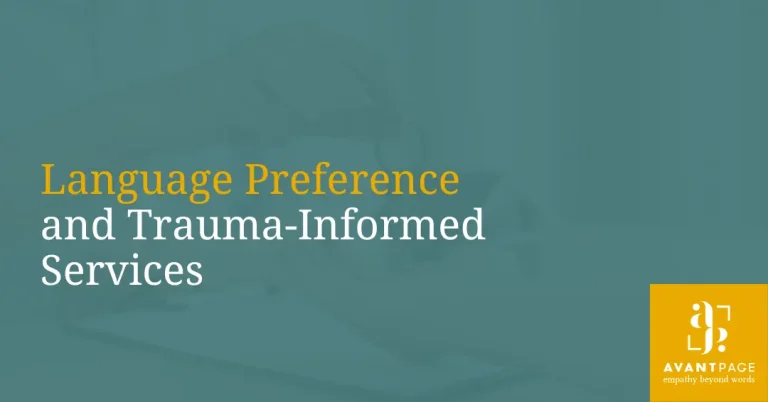
Language Preference and Trauma-Informed Care
Table of Contents - What Is Trauma-Informed Care? - Why Trauma-Informed Language Services Matter for Healthcare, Legal, and Social Service Providers - General Considerations for Interpreting Settings - Trauma-Informed Care: Special Considerations - 1. Gender Preferences - 2. Age Preferences - 3. Language Preferences - 4. Community Dynamic - 5. Interpreter's Preference - How Avantpage Delivers Trauma-Informed Interpreting - Why Trauma-Informed Care Is Critical to Spoken Communication - Frequently Asked Questions About Trauma-Informed Services - Partner With a Language Service Provider Trained in Trauma-Informed Care Navigate a person-centered care system through trauma-informed language services.
At the surface level, language services like translation and interpreting might seem like fairly straightforward processes: You take content (or speech) in one language, and reproduce the meaning and message in another. But in practice, it’s all a lot more complicated than that. Translators and interpreters have to take all sorts of other considerations into account, from the specific context of the source to the audience who will be receiving the message in the target language. After all, the content you might read in an advertisement is worlds away from the language a medical interpreter has to relay back and forth between a patient and their doctor. And certain settings, such as healthcare, emergency services, and legal services, may require providers of language services to take into account the trauma that a person might have experienced before needing those services. As a result, translation and interpretation become inextricably linked with providing trauma-informed care, and it’s important that language service providers working in these sectors be able to pair non-English-speaking individuals who’ve suffered trauma with interpreters who are well-equipped to provide trauma-informed language services. For language service providers working in these domains, translation and interpreting are far from just matching and pairing languages — it’s also about making sure individuals with limited English proficiency (LEP) get the care they need and are able to advocate for themselves in light of traumatic experiences. Interpreters in particular are likely to work with clients and patients who need trauma-informed services. When working with individuals who have dealt with traumatic experiences — whether it’s violence or serious injury — interpreters need to be knowledgeable about how to effectively provide trauma-informed care. Here, we’ll discuss what trauma-informed care looks like and what interpreters and language service providers in general can do to ensure that they’re providing effective and sensitive trauma-informed language services. Trauma-informed care is a way to provide effective care and services to individuals who may have experienced some form of trauma. It’s a matter of being sensitive to an individual’s traumas and making sure that they’re able to receive adequate care in response to these traumatic events. Revisiting and discussing traumatic events can actively harm somebody’s mental well-being — as a result, it’s important to be sensitive when providing care to people who have faced such trauma. In recent years, providers of both legal and medical services have championed ways to provide trauma-informed services, from reframing the way they talk about traumatic events to avoiding triggering topics altogether. Providing trauma-informed care can be even trickier when there’s a language and/or cultural barrier. As a result, using interpreters who are specialized in providing trauma-informed care can help build bridges for limited English proficient individuals to receive adequate care. In addition, nationally recognized frameworks such as SAMHSA’s Six Principles of Trauma-Informed Care (Safety, Trustworthiness, Peer Support, Collaboration, Empowerment, and Cultural/Historical/Gender Sensitivity) play an important role in shaping how language access providers support LEP individuals. Incorporating these principles helps ensure that communication is not only accurate but also emotionally safe and culturally aligned. For organizations serving vulnerable populations, trauma-informed language access is more than a best practice — it’s a compliance requirement and patient safety issue. Providers must consider: When communication is unclear or emotionally triggering, organizations may see increased safety risks, misdiagnosis, patient dissatisfaction, or legal complications. Effective trauma-informed interpreting helps reduce these risks while supporting a more compassionate, person-centered care approach. Before delving into trauma-informed language services specifically, it’s worthwhile to go over some general considerations that apply to most interpreting settings. These include: The key consideration to keep in mind when providing trauma-informed services is the emotional and physical well-being of the client or patient. Trauma-informed language services acknowledge the potential vulnerability, distress, or triggers that individuals may experience in sensitive or traumatic situations. By implementing trauma-informed practices and considerations, language service providers can create a safe and supportive environment for effective communication and healing. Here are some additional considerations language service providers should take into account when working with patients who have experienced some form of trauma. Traumatic experiences can lead individuals to feel more comfortable or safe when communicating with an interpreter of a specific gender. Respecting this preference can create an environment that’s conducive to open communication and trust. Similarly, some individuals may find it easier to connect and share their experiences with interpreters within a specific age range. Victims of violence may prefer to avoid interpreters of the same age as their attacker, but broadly speaking, an age preference can also be influenced by cultural factors, life experiences, or personal comfort. Speakers of English as a second language (ESL) may prefer to work with an interpreter even if they don’t have LEP. Generally speaking, it’s easier to convey subtle nuances and express yourself in your native language — it’s hard enough to gather your thoughts after a traumatic experience, so it’s important to respect ESL speakers’ desire to work with an interpreter if they request one. Additionally, speaking through an interpreter from the same linguistic background can help build trust. Some clients may prefer to avoid working with interpreters who they know personally — others may feel safer with somebody they do know. This is particularly important to consider in small communities where an interpreter is more likely to know many members of their linguistic community, but in any setting, it’s important to consider the degree of anonymity a client or patient would like when receiving language access services. Certain words and phrases (particularly body parts and expletives) can be triggering to both the client and the interpreter. It’s important for language service providers to know what a certain interpreter may or may not be comfortable with interpreting. Assigning an interpreter who’s uncomfortable with certain phrases and topics could have a negative impact on the overall integrity of their interpretation, so it’s important to make sure your interpreter’s boundaries. It’s also important to note that these considerations go beyond trauma-informed services as well — even if a client hasn’t experienced severe trauma that you know of. While especially so in particular settings, being sensitive to a client or patient’s needs and triggers is critical to providing effective language services. To support organizations that serve vulnerable or high-risk populations, Avantpage has built specialized processes, training, and quality controls designed specifically for trauma-informed communication. These include: These safeguards help healthcare providers, legal entities, and social service organizations deliver care that is compassionate, culturally aligned, and clinically accurate, even in the most sensitive contexts. A trauma-informed approach to language access services is absolutely crucial, especially when it comes to interpreting for patients and clients in need of mental health, medical, or legal services. By considering an individual’s needs, experiences, and preferences, language service providers can deliver more effective and supportive services. Here are just a few things you should keep in mind when providing interpreting services in a sensitive or trauma-informed setting: A specialized form of interpreting that incorporates emotional safety, cultural sensitivity, and best practices designed to avoid retraumatization. Absolutely! Video remote interpreting (VRI) is often preferred for trauma-informed settings because it allows for visual cues while preserving privacy if anonymity is needed. Look for providers that include trauma-informed training, follow CLAS Standards, comply with Title VI, and demonstrate experience in clinical and legal settings — all areas where Avantpage excels. It minimizes the chance of miscommunication, supports emotional well-being, and helps providers maintain compliance with federal language access requirements. If your organization supports vulnerable communities, trauma survivors, or individuals navigating complex legal or medical systems, choosing the right language access partner is essential. Avantpage provides trauma-informed interpreting, professional translation, and culturally aligned communication services designed to protect safety, dignity, and trust. Ready to strengthen your approach to trauma-informed care? Contact us online or call (530) 750-2040 to speak with our team about building a tailored interpreting solution.
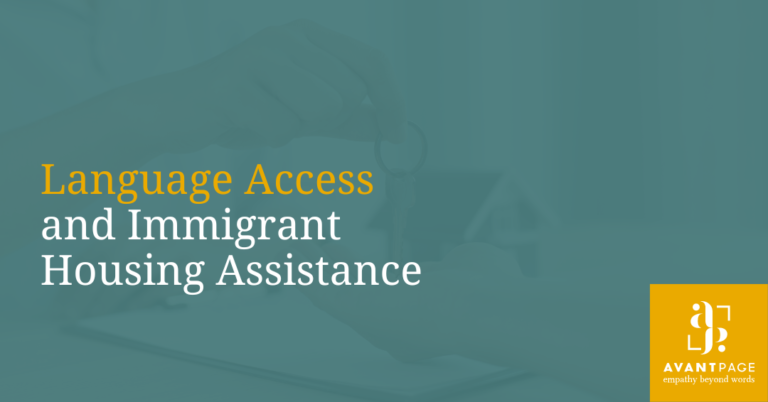
Language Access and Immigrant Housing Assistance
Although it’s illegal for rental agencies and mortgage lenders to discriminate against individuals on the basis of their English proficiency, we would be remiss not to acknowledge a clear reality: Individuals with limited English proficiency (LEP) tend to face greater housing instability than their English-speaking counterparts. This makes immigrant housing assistance absolutely critical to ensuring that individuals with LEP have a fair chance at securing housing and remaining housed. When it comes to home ownership, areas with high concentrations of LEP have been found to have a rate of home ownership that’s 5% lower than those with lower populations of individuals with LEP. Meanwhile, some rental agencies still refuse to rent to individuals with LEP — one in New York even caught the attention of the US Department of Justice after being accused of refusing to work with LEP individuals even after they offered to pay for their own interpreting services. Communities with LEP comprise a diverse group of people — immigrants, refugees, asylum seekers, and other displaced individuals, just to name a few. Among individuals with LEP, refugees and asylum seekers face unique challenges, as they often lack the resources to prepare for immigration or establish themselves in the country after leaving politically unstable regions. As refugees and asylum seekers arrive in the country, one of their most pressing needs is finding and securing housing accommodations. These individuals tend to be some of the most vulnerable to housing instability, as they may not be immediately ready to navigate the complex housing market upon arrival, especially if they don’t have a strong grasp of English or an established network within the country. Organizations like housing counseling agencies (HCAs) and the Department of Housing and Urban Development (HUD) provide immigrant housing assistance resources and services to equip these folks with the aid that they need. However, it’s crucial to provide these services alongside adequate language access services; otherwise, immigrants and refugees with LEP may not be able to take full advantage of housing assistance. In this blog post, we’ll explore the intersection of language access and immigrant housing assistance, highlighting the importance of equitable language access to support immigrant populations in their pursuit of suitable housing.
To effectively assist immigrant populations with their housing needs, it’s important that housing assistance — whether that’s emergency shelter needs or helping members of a family avoid eviction from their rental unit — be provided in a language that individuals can readily understand. There are a lot of key elements that go into making sure that individuals with LEP are able to find and access housing assistance services — here are just a few tips for housing organizations to enhance outreach and support for individuals with LEP: While it’s clearly important for agencies to provide services to individuals with LEP in a language they can understand, it’s equally important for said agencies to reach those individuals in the first place. After all, if individuals struggling with housing are not aware of or do not fully understand the available assistance, they may not be able to access the help they need. Because of this, it’s important that HCAs and other organizations providing housing assistance to immigrants make an effort to connect with individuals in their advertising and outreach materials — for example, translating (or even transcreating) informational pamphlets into languages that are in high demand within the local community, or directing social media and advertising campaigns toward non-English-speaking communities that are most in need. Partnering with CBOs that have established connections with immigrant communities can significantly improve language access in housing assistance. These organizations can provide valuable insight and cultural expertise to ensure effective communication and service delivery. Not only can they help you with your outreach plans, but they can also help give you an idea of the languages that are most in demand, and also provide consulting as you develop a language access plan. Although English is the most common language on the internet, it’s clear that people prefer accessing websites in their native language. Individuals with LEP will almost certainly be using the internet in a language other than English — so if your website is English-only, people in need may not easily find your website on search engines. That makes it absolutely essential for housing organization websites to localize their websites to cater to diverse linguistic communities. For tips on localization practices, visit our recent blog post on localization mistakes to avoid. A robust language access plan is an absolute must-have for any organization providing immigrant housing assistance. A good language access plan will guide the ways in which your organization interacts with individuals who have LEP, including (but not limited to) the following actions:
These are just a few important considerations when establishing a language access plan — for more information on creating an effective language access plan, click here. Developing an online portal specifically designed for immigrant housing assistance, translated into multiple languages, can help streamline things for individuals with LEP. This portal can help connect clients with housing counselors who speak their preferred language and can also allow individuals to easily access translated vital documents. Individuals can also use the portal to schedule counseling sessions and communicate whether or not they’ll need an interpreter before their session begins, so the agency can be well-prepared ahead of time.
One’s level of English proficiency should never impact their ability to secure or remain in suitable housing. By recognizing the intersection of language access services and immigrant housing assistance, HCAs and other organizations providing housing assistance can serve their clients with LEP effectively and efficiently. Here are five tips to get you started: Avantpage is proud to help housing organizations provide effective and inclusive language services for some of the most vulnerable individuals. If your housing agency is looking to develop a language access plan or simply needs translation, localization, or interpreting services, we’re here to help — contact us today at [email protected] or (530) 750-2040 to learn more about our services.
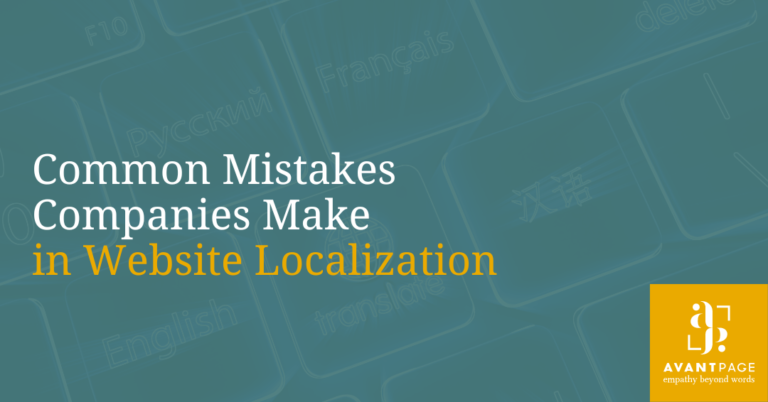
Common Mistakes Companies Make in Website Localization
While there’s no one-size-fits-all website localization strategy for reaching a global audience, it’s hard to overestimate the importance of speaking your target audience’s language. Although English is — for better or worse — the internet’s lingua franca, it’s also true that most people throughout the world prefer to buy products and services that are marketed in their native language. If you’re trying to reach people from different linguistic and cultural backgrounds in your community and improve your organization’s language access, it’s absolutely critical to have a thorough website localization strategy. Website localization plays a pivotal role in making your services accessible to all and ensuring that folks with limited English proficiency are able to meaningfully find and use your services. But all too often, website localization is done all wrong — whether it’s using Google Translate as a shortcut or ignoring important design features, we’ve seen a lot of localization mistakes. In this blog post, we’ll go over some of the most frequent mistakes seen in website localization strategy according to our resident localization expert, Fernanda Aguilera — and why you should avoid them. Case Study: How Avantpage Completed Website Localization for Covid19.ca.gov in 7 languages with +10 million views
Outside of the language services industry, localization is often conflated with the mere translation of text. While that’s certainly one important aspect of localization, it’s far from the only consideration to make when localizing a website. Localization services aim to ensure that your content adheres to the linguistic and cultural conventions of your target audience. Ultimately, website localization is a holistic approach that aims to bridge language access, cultural competency, and user journey to ensure that users who speak different languages are able to access your content as if it were created specifically for their locale and offers equal access to your organization’s offerings. By adapting your web content to the local language and culture, you create a more meaningful and engaging experience for diverse audiences. Website localization increases user satisfaction and improves access to services, therefore improving equity overall in areas of social determinants of health. But that’s only when it’s done well — poor localization practices like culturally inaccurate references and bad translation have been shown to damage a brand’s reputation. In a survey conducted last year, researchers found that 24% of prospective customers would trust a brand less if their website featured poor localization practices.
If you’re just beginning to localize your website into your threshold languages — or if you want to improve upon past efforts to do so — here are 14 common mistakes seen by our resident localization expert, Fernanda Aguilera you’ll want to avoid in the process. Website localization incorporates elements of translation, design, and user experience that are critical to keep in mind when reaching diverse audiences. Whether you translate your text into the wrong dialect of a language or simply forgot to update your hyperlinks, the localization mistakes above can have a profound impact on your multilingual audiences’ ability to navigate your website. If you’re starting from scratch or need help correcting some of the above mistakes on a past project Avantpage is happy to jump in and help. Contact us today at [email protected] or (530) 750-2040 for more information about our localization services.
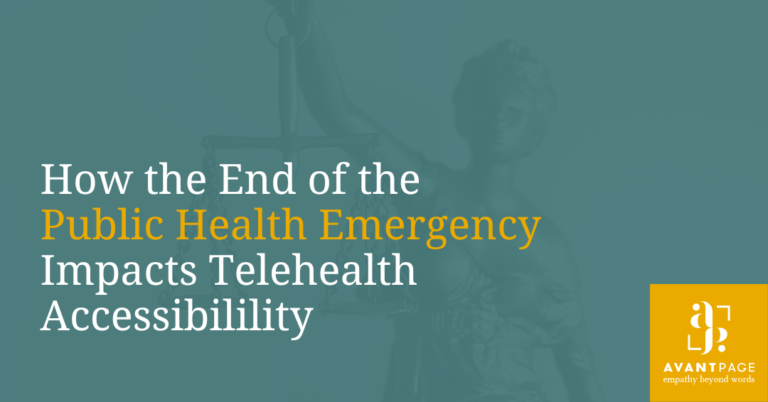
How the End of the Public Health Emergency Impacts Telehealth Accessibility
You probably don’t need us to remind you that in 2020, the United States declared the COVID-19 pandemic to be a public health emergency (PHE) — but now it’s looking like we’re finally in the clear, after three years of masking, social distancing, and working from home. That’s not to say the pandemic’s over or that we no longer need to worry about COVID-19 — just that the state of emergency is over. Last month, the United States officially ended the PHE that was put in place more than three years ago. Among other aspects of daily life, the PHE had a profound impact on healthcare and how we access it — as such, the PHE ending is also likely to have an equally profound impact on telehealth. “[The Department of Health and Human Services] and the leadership across the Department remain focused on protecting the health and well-being of all Americans, particularly those at highest at risk, including seniors and immunocompromised people, making sure we don’t leave the uninsured behind, and monitoring the latest subvariants so we’re prepared and ready to manage the risks of the virus moving forward,” secretary of health and human services Xavier Becerra said in a statement on May 11, when the PHE officially ended. In response to the PHE, doctors and other healthcare providers adopted several telehealth measures and practices to allow patients and healthcare workers to stay safe in the face of COVID-19. The US Department of Health and Human Services first declared a PHE in response to COVID-19 in late January 2020. But it wasn’t until about a month and a half later that things began to hit the fan. In mid-March of that year the number of people diagnosed with COVID started rising fast — in response, businesses began to close their doors, students attended class on their laptops, and the video communications platform known as Zoom became a household name. During the PHE, virtual doctor’s appointments and other forms of telehealth became more prominent — this was possible because the PHE relaxed certain HIPAA requirements and allowed patients to file insurance claims for more telehealth services. And in the language services domain, remote interpreting became an even more important method of delivering services than before. The shift to telehealth meant healthcare providers had to rely on remote interpreting technology more than ever before. It certainly stands to reason that this change should have had a positive impact on patients with limited English proficiency (LEP). Instead, it seems that telehealth was often less accessible to patients with LEP than those without. From problems with digital literacy to inaccessible user journeys, many patients with LEP struggled to receive the care they needed during the PHE. As we transition into this post-PHE era, here’s what healthcare providers — telehealth or otherwise — should know about accessing language services and providing equitable care to patients with LEP.
Throughout the COVID-19 pandemic, language barriers have posed challenges to effective healthcare delivery for individuals with LEP. Even before the pandemic, healthcare providers have had to take measures to break language barriers for patients with LEP. But the pandemic and the shift to telehealth under the PHE made things even tougher. Insufficient digital literacy, lack of access to digital requirements like broadband internet among certain populations with LEP, and occasionally erroneous or misleading translations of important public health information made it harder for patients with LEP to access telehealth. And as a result, research suggests that populations with LEP were more likely to suffer adverse consequences from COVID-19 than other groups. These disparities shed some much-needed light on the importance of language access in healthcare. Ultimately, the PHE created a motive for healthcare providers to develop programs and innovative solutions to address language access barriers and ensure equitable healthcare for all.
With the end of the PHE last month, many healthcare providers will be less likely to rely upon certain telehealth practices. And some things that were allowed under the PHE — for example, a relaxation of HIPAA that let providers who were covered by Medicare to use WhatsApp and FaceTime — will no longer be allowed. Likewise, the end of the PHE also means that doctors are no longer able to prescribe controlled substances to patients via telehealth alone. Patients will be required to come in for an in-person visit with the doctor before any such prescriptions can be written or filled. While video doctors’ appointments will certainly stick around, they’ll likely become less common than they were during the pandemic — especially since fewer telehealth visits will be covered by insurance, requiring many patients to default to onsite visits to the doctor. This means patients with LEP could potentially have to travel longer distances to meet with a doctor who speaks their language. Healthcare providers will still be able to use remote interpreting technology to get connected with an interpreter, in the event that a patient needs an interpreter. Demand for in-person interpreting may increase, however, as doctors begin to shift away from telehealth appointments and technologies. Additionally, healthcare providers may need to reevaluate their language access practices to ensure that they meet the needs of patients who are coming into the office or hospital. In-person appointments introduce additional layers — for example, interacting with the receptionist at the front desk — that could cause friction if language access isn’t adequately considered.
About a month into this new chapter, it’s critical that healthcare providers consider ways in which the end of the PHE might impact the accessibility of telehealth services. Here are some things for healthcare providers to keep in mind during this critical junction: As we transition into this new phase of the pandemic, Avantpage is proud to provide consulting, translation, and interpreting services to healthcare providers all across the country. If you need to work on revising your language access plan for the post-PHE era, don’t hesitate to contact us at [email protected] or (530) 750-2040 for more information about our services.